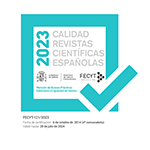El arte y la tierra en Martin Heidegger y Eduardo Chillida
Abstract
There is a deep relationship between the way Martin Heidegger concieves the idea of earth in his lectures on art, and the vision of matter Eduardo Chillida develops and gives shape in his work. According to Heidegger, the artist makes use of wood, stone, colour, etc. paying tribute to the peculiarity of the chosen matter and bringing to light the true nature of earth. All work of art presents for him two perspectives: One is provided by the world, the other by the earth. If the first supplies the ties between the artistic manifestations and humans’ life, the latter shapes the enigmatic ground where the work retracts. The same idea of the earth resounds in Chillida’s work, an artist who deals with matter by ear, trying to «listen» to what is hiding in it. Through this procedure, he aspires to «catch» the fleeing space and make it resound in the limits of the shaped volumes. He establishes for himself a double challenge: stop space, i. e. the «fast matter», and face the gravity of the matter, i. e. the «slow space».Downloads
Article download
License
In order to support the global exchange of knowledge, the journal Arte, Individuo y Sociedad is allowing unrestricted access to its content as from its publication in this electronic edition, and as such it is an open-access journal. The originals published in this journal are the property of the Complutense University of Madrid and any reproduction thereof in full or in part must cite the source. All content is distributed under a Creative Commons Attribution 4.0 use and distribution licence (CC BY 4.0). This circumstance must be expressly stated in these terms where necessary. You can view the summary and the complete legal text of the licence.










